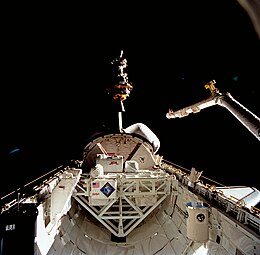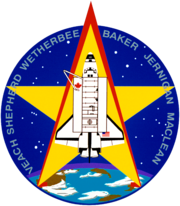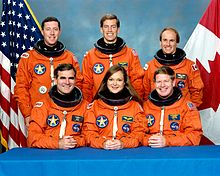STS-52
 Columbia's payload bay, with the LAGEOS II satellite (top) being deployed | |
| Mission type | Microgravity research Satellite deployment |
|---|---|
| Operator | NASA |
| COSPAR ID | 1992-070A |
| SATCAT no. | 22194 |
| Mission duration | 9 days, 20 hours, 56 minutes, 13 seconds |
| Distance travelled | 6,645,026 kilometers (4,129,028 mi) |
| Orbits completed | 159 |
| Spacecraft properties | |
| Spacecraft | Space Shuttle Columbia |
| Landing mass | 113,457 kilograms (250,130 lb)[1] |
| Payload mass | 8,078 kilograms (17,809 lb) |
| Crew | |
| Crew size | 6 |
| Members |
|
| Start of mission | |
| Launch date | 22 October 1992, 17:09:39 UTC[2] |
| Launch site | Kennedy LC-39B |
| End of mission | |
| Landing date | 1 November 1992, 14:05:52 UTC[2] |
| Landing site | Kennedy SLF Runway 33 |
| Orbital parameters | |
| Reference system | Geocentric |
| Regime | Low Earth |
| Perigee altitude | 160 nautical miles (300 km)[2] |
| Apogee altitude | 163 nautical miles (302 km)[2] |
| Inclination | 28.45 degrees[2] |
| Period | 90.6 min |

 Left to right - Back: Baker, Wetherbee, Maclean; Front: Veach, Jernigan, Shepherd | |
STS-52 was a Space Transportation System (NASA Space Shuttle) mission using Space Shuttle Columbia, and was launched on 22 October 1992.[3]
Crew[]
| Position | Astronaut | |
|---|---|---|
| Commander | James D. Wetherbee[4] Second spaceflight | |
| Pilot | Michael A. Baker[4] Second spaceflight | |
| Mission Specialist 1 | Charles L. Veach[4] Second and last spaceflight | |
| Mission Specialist 2 | William M. Shepherd[4] Third spaceflight | |
| Mission Specialist 3 | Tamara E. Jernigan[4] Second spaceflight | |
| Payload Specialist 1 | Steven G. MacLean[4], CSA First spaceflight | |
Backup Crew[]
| Position | Astronaut | |
|---|---|---|
| Payload Specialist 1 | Bjarni Tryggvason[4], CSA First spaceflight | |
Mission highlights[]

Primary mission objectives were deployment of the Laser Geodynamics Satellite II (LAGEOS-II) and operation of the U.S. Microgravity Payload-1 (USMP-1). LAGEOS-II, a joint effort between NASA and the Italian Space Agency (ASI), was deployed on day 2[2] and boosted into an initial elliptical orbit by ASI's Italian Research Interim Stage (IRIS). The spacecraft's apogee kick motor later circularized LAGEOS orbit at its operational altitude of 3,666 miles. The USMP-1, activated on day one, included three experiments mounted on two connected Mission Peculiar Equipment Support Structures (MPESS) mounted in the orbiter's cargo bay. USMP-1 experiments were: Lambda Point Experiment; Matériel Pour L'Etude Des Phénomènes Intéressant La Solidification Sur Et En Orbite (MEPHISTO),[5] sponsored by the French agency Centre National d'Études Spatiales; and Space Acceleration Measurement System (SAMS).[3]
Secondary payloads: (1) Canadian experiment, CANEX-2, located in both the orbiter's cargo bay and middeck and which consisted of Space Vision System (SVS); Materials Exposure in Low-Earth Orbit (MELEO); Queen's University Experiment in Liquid-Metal Diffusion (QUELD); Phase Partitioning in Liquids (PARLIQ); Sun Photospectrometre Earth Atmosphere Measurement-2 (SPEAM-2); Orbiter Glow-2 (OGLOW-2); and Space Adaptation Tests and Observations (SATO).[6] A small, specially marked satellite, the Canadian Target Assembly, was deployed on day nine, to support SVS experiments. (2) ASP, featuring three independent sensors mounted on a Hitchhiker plate in the cargo bay - Modular Star Sensor (MOSS), Yaw Earth Sensor (YES) and Low Altitude Conical Earth Sensor (LACES), all provided by the European Space Agency.[7]
Other middeck payloads: Commercial Materials Dispersion Apparatus Instrument Technology Associates Experiments; Commercial Protein Crystal Growth experiment; Chemical Vapor Transport Experiment; Heat Pipe Performance Experiment; Physiological Systems Experiment (involving 12 rodents); and Shuttle Plume Impingement Experiment. The orbiter also was used as a reference point for calibrating an Ultraviolet Plume Instrument on an orbiting Strategic Defense Initiative Organization satellite.[8]
The Tank Pressure Control Experiment/Thermal Phenomena (TPCE/TP) was contained in a Getaway Special (GAS) canister in the orbiter's cargo bay.[9]
Some of the ashes of Star Trek creator Gene Roddenberry were also carried aboard the orbiter for the duration of the mission.[10]
Wake-up calls[]
NASA began a tradition of playing music to astronauts during the Gemini program, and first used music to wake up a flight crew during Apollo 15. A special musical track is chosen for each day in space, often by the astronauts' families, to have a special meaning to an individual member of the crew, or in reference to the day's planned activities.[11]
| Day | Song | Artist/Composer | Played For |
|---|---|---|---|
| Day 2 | Wake Up Columbia | Crow Carroll | |
| Day 3 | Shake, Rattle and Roll | Big Joe Turner | Deployment of LAGEOS-II |
| Day 5 | The World is Waiting for the Sunrise | Les Paul and Mary Ford | |
| Day 6 | Birthday | The Beatles | Mike Baker's 39th Birthday |
| Day 7 | "Hawaiian music" | ||
| Day 8 | Mack the Knife | Bobby Darin | |
| Day 9 | Bang the Drum | Todd Rundgren | |
| Day 10 | Monster Mash | Bobby "Boris" Picket | It was Halloween |
| Day 11 | Notre Dame Victory March | JSC employees & Notre Dame grads | James Wetherbee |
See also[]
References[]
![]() This article incorporates public domain material from websites or documents of the National Aeronautics and Space Administration.
This article incorporates public domain material from websites or documents of the National Aeronautics and Space Administration.
- ^ Rumerman, Judy A. (2009). "3B". NASA Historical Data Book (PDF). VII. NASA History Division. pp. 435–437. Archived (PDF) from the original on 22 April 2021. Retrieved 22 April 2021.
- ^ a b c d e f "STS-52 Space Shuttle Mission Report" (PDF). NTRS - NASA Technical Reports Server. NASA. December 1992. Archived (PDF) from the original on 22 April 2021. Retrieved 22 April 2021.
- ^ a b Ryba, Jeanne (31 March 2010). "STS-52". Space Shuttle - Mission Archives. NASA. Archived from the original on 22 April 2021. Retrieved 22 April 2021.
- ^ a b c d e f g Orloff, Richard W. (October 1992). "STS-52 Press Kit" (PDF). JSC History Collection. NASA. Archived (PDF) from the original on 22 April 2021. Retrieved 22 April 2021.
- ^ Chen, Adam (2012). Wallack, William; George, Gonzalez (eds.). Celebrating 30 years of the space shuttle (PDF). NASA. p. 109. ISBN 978-0-16-090202-4. Archived (PDF) from the original on 22 April 2021. Retrieved 22 April 2021.
- ^ Chowdhury, Abul A. (6 October 2020). "STS-52". Life Sciences Data Archive. NASA. Archived from the original on 22 April 2021. Retrieved 22 April 2021.
- ^ Aceti, R.; Trischberger, M.; Underwood, P. J.; Pomilia, A.; Cosi, M.; Boldrini, F. (1 October 1993). "Attitude Sensor Package" (PDF). NTRS - NASA Technical Reports Server. NASA. Archived (PDF) from the original on 22 April 2021. Retrieved 22 April 2021.
- ^ "1981-1999 Space Shuttle Mission Chronology" (PDF). NASA. Archived (PDF) from the original on 22 April 2021. Retrieved 22 April 2021.
- ^ Dumoulin, Jim (29 June 2001). "STS-52". Kennedy Space Center's Science, Technology and Engineering Homepage. NASA. Archived from the original on 22 April 2021. Retrieved 22 April 2021.
- ^ Goodman, Rebecca (23 October 2012). "This Week @ NASA, October 23, 2012". NASA Podcasts. NASA. Archived from the original on 22 April 2021. Retrieved 22 April 2021.
...Columbia also carried to space ashes of Star Trek creator, Gene Roddenberry
- ^ Fries, Colin (13 March 2015). "Chronology of Wakeup Calls" (PDF). NASA History Division. NASA. pp. 24–25. Archived (PDF) from the original on 22 April 2021. Retrieved 22 April 2021.
External links[]
- Space Shuttle missions
- Spacecraft launched in 1992
